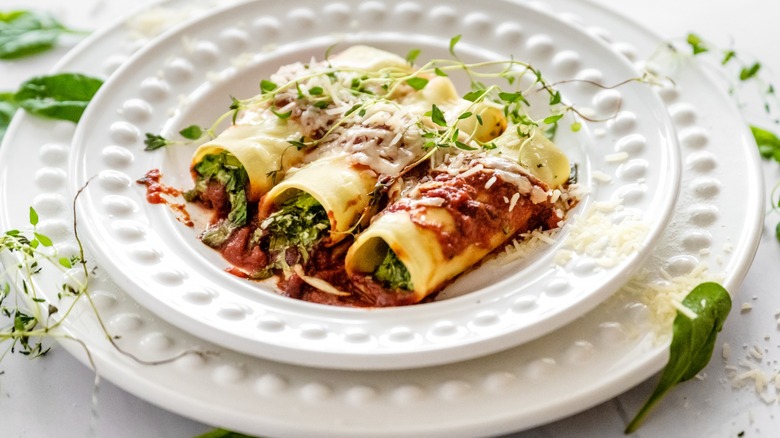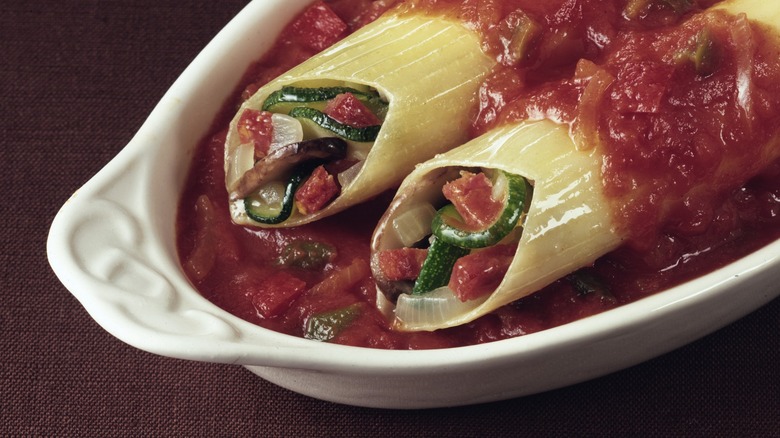Cannelloni Vs Manicotti: What's The Difference?
There are an estimated 350 different pasta shapes in the world, giving pasta a vast fanbase that goes way beyond its Italian origins. Gathering with family around a warm bowl of spaghetti or huddling on the couch with a serving of mac and cheese is the edible equivalent of giving yourself a hug. Regardless of how amazing pasta can be, attempting to sample every pasta shape in the world would be nearly impossible. That doesn't mean you shouldn't recognize the different pasta shapes when you see them. though.
Many pastas are named for how they're shaped. For example, the word spaghetti comes from the Italian term "spago," which means string. Farfalle, or bowtie pasta, translates to "Butterfly." Some people confuse Manicotti with its cousin Cannelloni. If you've seen them on the menu at a restaurant and been unsure of what's what, you're not alone. People often use these names interchangeably, however erroneously. They're both tubes that get stuffed with various ingredients. However, they're more different than you would think, particularly when it comes to their evolution throughout history.
Cannelloni
When you think about cannelloni, you likely picture large cylinders of pasta stuffed with meat or vegetables and cheese and topped off with sauce, all baked into gooey goodness. You're not wrong, but that's not the whole picture.
The Italian word behind Cannelloni's name means "large reeds," which is an accurate representation of this pasta's final form. Traditionally, cannelloni pasta starts out as a rectangular sleeve of pasta that measures about 3 inches by 4 inches. After boiling the noodles until tender, they receive a dollop of filling and get rolled into tubes. After spooning sauce and sometimes cheese over the top, the whole dish goes into the oven to come together. To make this pasta at home, you'll have to find rectangular cannelloni noodles or try your hand at homemade pasta. If neither of those options works for you, lasagna noodles can fill in as well. Sometimes people will use pasta shells to hold the filling.
Cannelloni pasta is an authentic Italian dish as the sleeves are most often rolled out by hand. On the other hand, manicotti, a pasta that takes a similar shape, is typically formed by a machine.
Manicotti
Manicotti is one of the oldest pasta shapes in the world. While it's equally delicious, it's not the same as cannelloni. The word manicotti translates into "sleeves." This pasta comes out of the box shaped like a one-inch tube, so there's no rolling involved for the dough or the cooked noodles. Any manicotti recipe will involve a similar cooking process to cannelloni, in which the pasta gets stuffed and baked with sauce and cheese.
Traditionally, manicotti was made with crepes that were rolled into tubes around various hearty ingredients (much like cannelloni). Now, the dish has become Americanized with premade noodles, and many consider it the American version of cannelloni. One of the most noticeable differences between the two shapes is their texture. Manicotti pasta has ridges that give it some bite, while cannelloni is smooth and more tender.
Often, restaurants will serve manicotti topped with bolognese or bechamel. The stuffing can run the gamut of ingredients, from beef to vegetables.


